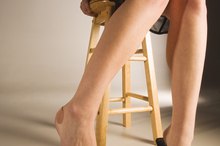Yoga & the Achilles Tendon
Your achilles tendon does the important job of connecting your heel bone to your calf. It's instrumental when you walk, run or jump — and you may just not have an appreciation for it, until something goes wrong.
If you are experiencing serious medical symptoms, seek emergency treatment immediately.
An inflammation at the achilles, known as achilles tendinitis, can cause discomfort, a dull ache and even shooting pain in the area behind your ankle and in your lower leg. A more serious achilles tendon tear or rupture means parts, or all in the case of a rupture, of this thick fibrous tissue has torn, and leads to swelling, severe pain and impaired movement.
Many yoga poses activate the achilles tendon 1. Think of when you stretch your heels toward the earth in Downward-Facing Dog, for example. If you have an achilles injury, your practice must be modified. Now, if you don't have an injury, yoga can help you keep the supple calves necessary to prevent damage. Yoga also offers a fabulous way to cross train this connective tissue that has high demands placed upon it every day.
Yoga for Calf Health
Tight or weak calf muscles put you at a higher risk of developing pain in your achilles tendon. Use yoga poses such as Warrior I or II, Side Angle, Crescent Lunge and Goddess to strengthen your calves.
Poses that stretch your calves include Eagle, Downward-Facing Dog and Forward Fold. Garland pose, or Malasana, is particularly good for your calves. It involves opening your feet as widely as you need and sitting down into a squat with your pelvis just inches from the floor. Bring your hands to the center of your chest as you breathe in this low squat for five to 10 breaths.
- Tight or weak calf muscles put you at a higher risk of developing pain in your achilles tendon.
- Bring your hands to the center of your chest as you breathe in this low squat for five to 10 breaths.
Yoga for Cross Training
Exercises to Slim Down for Naturally Muscular Women
Learn More
Achilles problems often arise from overuse, chronic hill running, wearing old or unsupportive shoes while exercising or exercising on soft surfaces. Yoga offers a way to counter all of these risk factors. You're constantly moving and changing position in a flowing yoga practice, so your feet bear your weight in different ways -- combating overuse. Bare feet in yoga supports healthy achilles and you usually practice on a hard floor covered by a thin mat, which can be healing for your achilles, too.
- Achilles problems often arise from overuse, chronic hill running, wearing old or unsupportive shoes while exercising or exercising on soft surfaces.
- Bare feet in yoga supports healthy achilles and you usually practice on a hard floor covered by a thin mat, which can be healing for your achilles, too.
Yoga with an Achilles Injury
Yoga is still available even if you're suffering from an achilles injury, the nature of that practice depends on the severity of your injury.
If you have tendinitis, keeping your heel from lengthening helps alleviate pain and avoids aggravating the achilles. So, in poses such as Downward Dog, don't force your heels toward the floor. If it's uncomfortable to set your back foot down in Warrior I, then come to the ball of your foot in a Crescent Lunge style posture. If the full poses aggravate your pain, shorten your stride, or take alternatives such as Cat/Cow in lieu of Downward Dog or kneel in Warrior I.
A tear or rupture that's put you in a boot means your practice will have to change notably. You may be restricted to yoga in a chair until you've healed or undergone surgery to repair the torn tendon. Once you're healing and out of the restrictive boot, take yoga as mostly seated poses on the mat. Over time, you'll ease into simple poses such as standing folds and knee-based lunges to keep your hips healthy. Always talk to your doctor about your exercise habits and ask her what movements are OK for you.
- Yoga is still available even if you're suffering from an achilles injury, the nature of that practice depends on the severity of your injury.
- If the full poses aggravate your pain, shorten your stride, or take alternatives such as Cat/Cow in lieu of Downward Dog or kneel in Warrior I.
- A tear or rupture that's put you in a boot means your practice will have to change notably.
Related Articles
References
- Sports Injury Clinic: Achilles Tendonitis
- Lopez RG, Jung HG. Achilles tendinosis: treatment options. Clin Orthop Surg. 2015;7(1):1-7. doi:10.4055/cios.2015.7.1.1
- Medina Pabón MA, Naqvi U. Achilles Tendonitis. Treasure Island (FL): StatPearls Publishing. Updated April 8, 2019.
- Tu P. Heel Pain: Diagnosis and Management. Am Fam Physician. 2018;97(2):86-93.
- Fakoya AOJ, Otohinoyi DA, Fakoya FA. Correlation of some predisposing intrinsic conditions with the morphological integrity of the Achilles tendon. Ann Afr Med. 2018;17(2):58-63. doi:10.4103/aam.aam_49_17
- Bass E. Tendinopathy: Why the Difference Between Tendinitis and Tendinosis Matters. Int J Ther Massage Bodywork. 2012;5(1):14-17.
- Gulati V, Jaggard M, Al-nammari SS, et al. Management of achilles tendon injury: A current concepts systematic review. World J Orthop. 2015;6(4):380-6. doi:10.5312/wjo.v6.i4.380
- Vyas S, Bhalla AS, Ranjan P, Kumar S, Kumar U, Gupta AK. Rheumatoid Arthritis Revisited - Advanced Imaging Review. Pol J Radiol. 2016;81:629-635. doi:10.12659/PJR.899317
- Kim J, Sung DJ, Lee J. Therapeutic effectiveness of instrument-assisted soft tissue mobilization for soft tissue injury: mechanisms and practical application. J Exerc Rehabil. 2017;13(1):12-22. doi:10.12965/jer.1732824.412
- Park YH, Jeong SM, Choi GW, Kim HJ. How early must an acute Achilles tendon rupture be repaired? Injury. 2017;48(3):776-780. doi:10.1016/j.injury.2017.01.020
- Maughan KL, Boggess BR. (2018). Achilles tendinopathy and tendon rupture. Fields KB, ed. UpToDate. Waltham, MA: UpToDate Inc.
Writer Bio
Andrea Boldt has been in the fitness industry for more than 20 years. A personal trainer, run coach, group fitness instructor and master yoga teacher, she also holds certifications in holistic and fitness nutrition.








